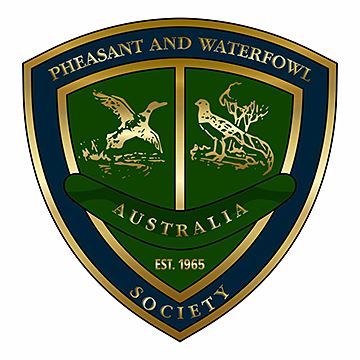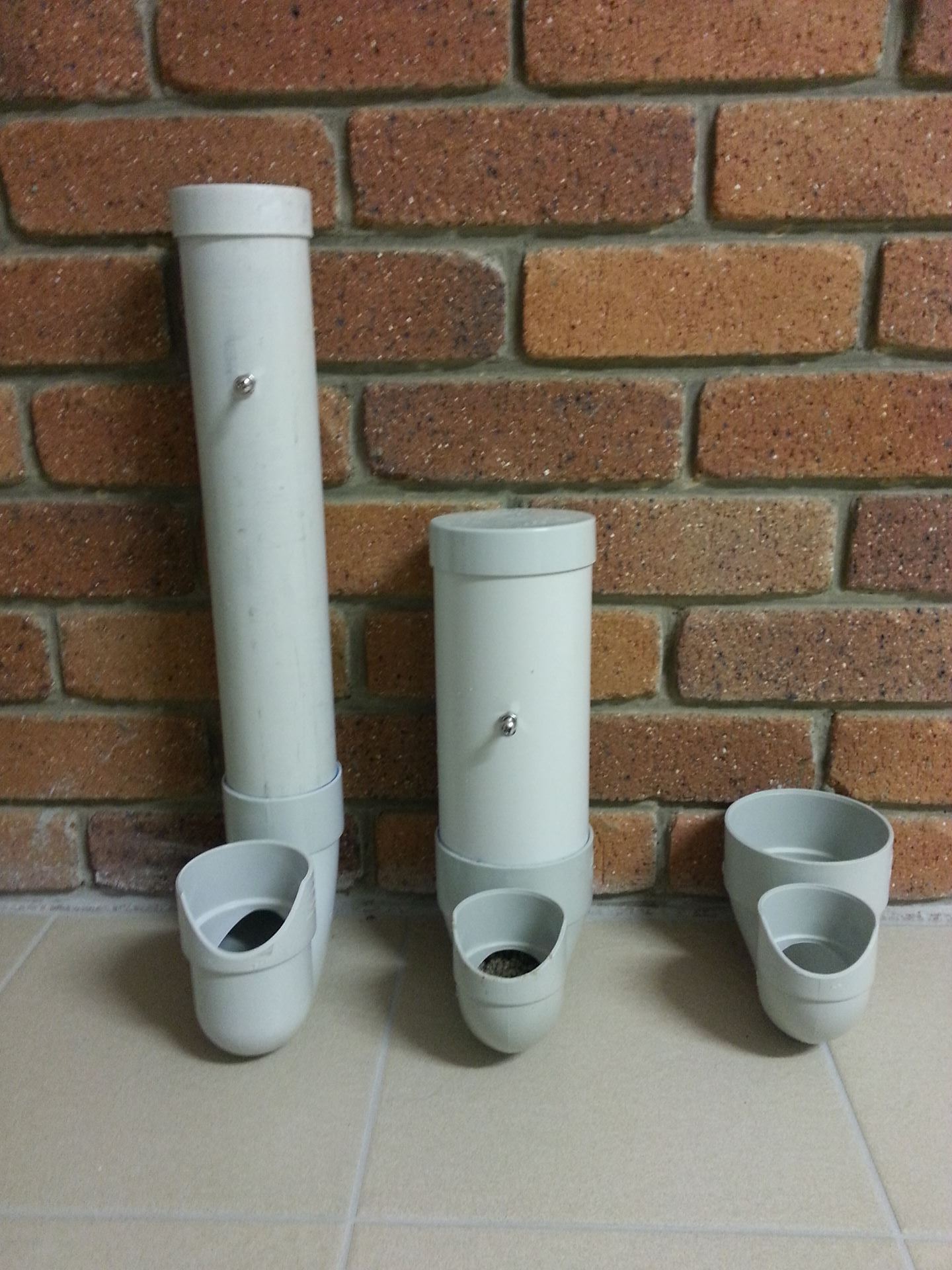 | supporting aviculture since 1965. |
CREATING AN AUTO FEEDER
Manufacture of a Pheasant/Poultry Feeder which reduces rodent access to food
Feed dispensing units have been manufactured from PVC fittings in various configurations for some time. I had been shown how to manufacture a feeder from a UPVC - 88 DWV Plain junction F & F fitting in the past and had seen many variations on that arrangement. It is easier to refine or redesign than to invent a design and it has been said that “imitation is the sincerest form of flattery”. With that adage in mind and the necessity to manage feed spillage from my pheasants, I perused local suppliers for suitable PVC fittings to home manufacture feed dispensing units. I noted the potential suitability of a 100 mm x 65 UPVC floor waste gully F & F fitting and my experimentation with that fitting resulted in this article. If feed dispensing, food spillage by pheasants and the associated costs is not a problem you need read no further. Pheasants have a capacity to waste extraordinary quantities of feed by dispersing their food near and far for what appears to be their own entertainment. A Reeves cock bird regularly demonstrated his capacity to waste pelletised feed prior to implementing an auto feeder. Generally pelletised food is deflected by abrupt sideways flicks of the head, with each movement displacing an amount of food. During early testing of the feed dispenser, I was initially concerned that low food usage rates indicated that the birds were not obtaining sufficient nutrition Those concerns were overcome when I established that reduced feed wastage explained the dramatic reduction in feed usage. The proposed feeder design is based on utilising “Solvent Cement Joint - PVC Non-Pressure - DWV (Drain, Waste & Vent) Sewer pipe & fittings which can be suitably manufactured at home with minimal tools and skills. BENEFITS OF A FUNCTIONAL FEED DISPENSER Pheasants are not concerned how their feed is dispensed and they will happily feed from any type of container or scavenge feed off the aviary floor. Potential benefits of effective feed dispensing include:- 1 Reduced rodent proliferation due to a reduction of available food. 2 Reduced costs related to feed wastage. 3 Reduced spoilage of feed due to bacterial and fungal attack. 4 Reduced internal parasite burden. Birds scavenging spilled feed from aviary floors may well result in re-ingestion of parasitic worm eggs passed from infected bird’s faeces, thus maintaining the cycle of internal parasitic infestation. COMPONENTS REQUIRED FOR MANUFACTURING THE FEED DISPENSING UNIT. A length of 100 nominal bore UPVC pipe (approximately 350 mm length is recommended) A UPVC - 100 x 65 trap (best practical size to prevent feed wastage) A UPVC - 100 nominal bore plain cap (push on) 30 cm of #8 gauge fencing wire One (1) off M 6 x 25 mm stainless steel round head set bolt and 2 nuts 1 container of UPVC solvent 1 container of UPVC solvent cement TOOLS NECESSARY FOR FEED DISPENSER MANUFACTURE Hacksaw or fine toothed saw Smooth file 6 mm diameter twist drill bit ¼” electric drill Pliers for shaping the wire suspension bridle. Rag for cleaning solvent/cement drips or spills. Solvent joint prep and gluing should be undertaken in a ventilated area away from naked flames. Instructions for use of PVC solvent and glue should be read, understood and followed. ESTABLISH THE QUANTITY OF FEED STORAGE REQUIRED Storage of excessive quantities of food in the aviary dispensing units may result in its deterioration due to fungal and bacterial spoilage. Consumption of spoiled food may result in ill health and potential death of pheasants. It is suggested approximately seven (7) days food is stored in feeders. Storage capacity should not be construed as weekly checks/inspection. Feed dispensers require regular visual inspection. MANUFACTURE OF THE FEED DISPENSER. The body of the feeder is manufactured from 100 mm nominal bore UPVC pipe which will store approx. 7 litres of food per lineal metre length. The desired length of plain tube is prepared for glue assembly. Ensure both ends of the tube are cut square and de-burred prior to assembly. Prepare one end for gluing by cleaning with solvent prior to applying glue and assembling. Apply solvent glue to both surfaces prepared for gluing and assemble. The push on cap is fitted to the open end (left loose and not glued) of the feeder to complete its manufacture. After assembly the 65 mm mm diameter trap outlet can be cut down at the front edge by a maximum 12 mm to improve accessibility to the food. It is suggested that a conservative approach is required as lowering the front edge excessively will lead to an increased probability of food wastage. Most birds will feed successfully without modification to the trap outlet. The leading edge of the fitting can be lowered utilising a hacksaw or fine toothed handsaw. The 100 x 65 trap UPVC fitting must be secured during cutting of the fitting. The proposed cut line can be penciled on to the fitting. The fitting is easier to secure if the fitting is attached by gluing to the 100 mm diameter main tube which forms the body of the feeder. The cut line should run from the upper side edges of the 65 mm diameter opening to a maximum depth of 12 mm at the front edge. Lowering of the front edge provides enhanced access to the pelletised feed. Do not cut down the sides of the outlet as removal of the side structure will enable the birds to displace food with sideways flicks of their beak. ACCUSTOMING BIRDS TO THE FEED DISPENSER Pheasants are extremely observant birds and few things escape their attention. They are inquisitive and will peruse additions to their environment. It is suggested that a visual clue is provided by manually topping up the feed dispenser with pelletised feed. The visual presence of feed at the feeder outlet and improved feed accessibility ensures the birds readily become accustomed to the new dispenser. POSITIONING THE FEED DISPENSER WITHIN THE AVIARY The feeder is hung from a single 6 mm diameter fastener which passes through a hole drilled in the front of the feeder tube. The fastener support is secured by clamping the tube between two nuts with one internal and the second external. The round head of the fastener projects externally from the body of the feeder which facilitates its suspension from a shaped wire bridle. The feeder is suspended by a galvanised steel wire bridle which is manufactured from a 30 cm length of #8 gauge fencing wire. The suspension bridle wire is shaped to form a “U” shape which fits neatly around the 100 mm diameter tube. The free ends should project equally on each side of the feeder. Place the “U” shaped bridle on a flat surface and bend one end to from a hook. Bend the second end to replicate the first hooked end. The “U” shaped bridle enables the feeder to hang vertically by the two hooked ends which are inserted (hooked) into the aviary wire. The feeder is positioned inside the “U” shaped bridle and lowered until the bridle is supporting the feed dispenser by the 6 mm diameter projecting support bolt. The mouth of the feed dispenser should be located approximately 10 cm above the aviary floor. A feeding platform consisting of common house bricks or pavers positioned in front of the outlet may enhance access by reducing the reach for the Pheasants to access food. The dispenser should be suspended in a dry location to prevent moisture ingress and subsequent spoilage of the feed. VERMIN MANAGEMENT AND THE FEEDER Mice and rats can be the scourge of the pheasant breeder. Minimising vermin’s available food source prevents them multiplying rapidly. Ability to shut down access to the food source can be achieved simply by introducing 65 mm push on caps. The vermin proof push on caps are inserted at the feeder opening each evening and removed each morning achieves the objective. Extension tubes inserted in the feeder opening prevents spillage of dispensed food and are used to minimise spillage by the pheasants. SELECTION OF SUITABLE FEED FOR DISPENSING Many pheasant display a childlike preference for specific items when offered multi grain diets. Elimination of specific food contents by preferred selection may lead to dietary deficiencies. I do not claim to be a dietary expert but accept that equal sized servings of ice cream at each daily meal do not constitute a balanced diet. Pelletised diets do not provide choice but a suitably balanced micro pellet diet ensures appropriate nutrition. SERVICING AND CLEANING THE FEED DISPENSER The feed dispenser is readily cleaned by washing with mild detergent and water. The feed dispenser design facilitates easy drying with a lint free cloth prior to filling with feed. Failure to effectively dry any feed dispenser after cleaning may result in the feed becoming rancid and fungal growth generation. Sieving pelletised feed to remove fines prior to topping up the feeder is recommended. An individual Pheasants preference for consuming whole pellets may result in a build-up of fines at the feeder mouth. The resultant endeavor to displace the unwanted fines by the bird may lead to feed wastage. The fines removed by sieving are suitable for consumption by other poultry species. If you have further questions, please feel free to Contact Us or find me on our Bird-Keeper Database! John Urane 2018 |
